
views
Reading the Poem

Read the poem out loud. Poetry is often written for the ear, so you should start by reading the poem out loud as it will help you listen to the poem more closely. Listen to the poem line by line, word by word. Notice the sounds the words make in your mouth. You may start to notice that the poem is using certain effects, like rhyming, word patterns, or line breaks, to create a certain mood or tone. Try to listen to what might be going on in the poem, especially the first time you read the poem out loud. You will need to read the poem out loud at least 3 times and really listen to each word on the page. If you are uncomfortable with reading poetry out loud, you may ask a friend or peer to read it for you so you can listen more closely without being distracted by your voice. The first time you read the poem out loud, focus on the imagery of the poem. Just listen to the words and notice the impression you get from them. The second time you read the poem out loud, pay attention to the action. What is happening in the poem? The third time, focus on the sounds. How do they contrast with or contribute to your understanding of the poem?

Make sure you read the poem in full. To fully understand the poem as a whole, you should make sure you read the poem from beginning to end. Read the title of the poem as well as the author, if noted. You should also read any endnotes or footnotes at the bottom of the poem, if any. The poem was written to form a whole piece, or work of art, so you should ensure that you read and digest all of it.
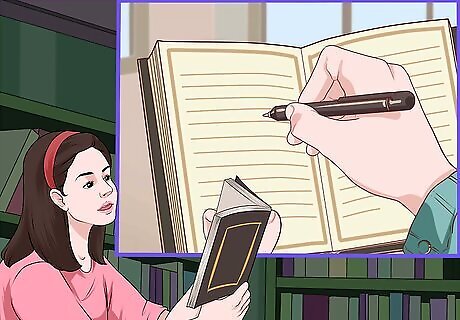
Mark down notes on the poem as you read it. You should have a pencil or pen ready as you read the poem out loud and in your head several times. Underline any words that have a strong meaning or an interesting sound to your ear. Circle any words that you find confusing or that jump out at you as important. You can also write notes to yourself in the margins of the poem. You may put a question mark next to a passage or line that strikes you as strange or unique. You may also write a note about the sound of certain lines or drawn arrows connecting certain lines to each other.
Determining the Subject and Context of the Poem

Consider the title of the poem. You should always start with the title of the poem, as the title can tell you a lot as a reader. Determine what the title is telling you and what expectations the title creates for you as a reader. You can use the title as a jumping off point for analyzing the rest of the poem. Maybe the title tells you about the subject of the poem, such as “Love and Friendship”, or the title labels the poem as a specific literary genre or type, such as “Ode to Melancholy” or “Sonnet 14.” Use the title as the first clue to what the poem might be about as well as certain themes or ideas in the poem. Write down your initial reaction to the title in the margins of the poem or on a piece of paper. What are your thoughts and expectations about the poem based on the title alone?

Identify the main subject of the poem. Once you have read the poem several times, out loud and to yourself, you should try to identify the main subject of the poem. Try to answer the question, what or who is the poem about? Try to be as detailed and precise as possible when you answer this question. Avoid a general statement or a vague impression of the subject of the poem. For example, perhaps you are trying to understand the poem, “I Hear America Singing” by Walt Whitman. You may determine that the poem is about America, both as a larger idea and as individual people part of a nation, such as “the boatman, the mason, the carpenter, the mother.” You may also think the poem is trying to look at the uniqueness of each individual American, where “Each singing what belongs to him or her and to none else” as well as how this uniqueness contributes to the idea of America as one nation, united.

Determine the key situation in the poem. You should consider the premise or situation of the poem. Determining the situation of the poem will help you get some grounding in the piece and situate yourself as a reader. Ask yourself several questions, such as, What appears to be going on in the poem? Who is talking and to whom? Where is the poem taking place? Why is the poem being told? Does the poem have a turning point where the tone, focus, or rhyme scheme changes? For example, perhaps you are analyzing Langston Hughes’ poem “The Negro Speaks of Rivers.” You may note that the speaker of the poem is “the negro” of the title and the poem is being told to help share the negro’s story and his history. You may realize that the poem is acting as a testament to the life of the negro, literally and figuratively.
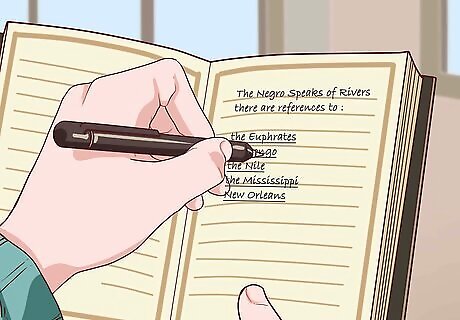
Note any references to literary or historical events. You should look for any allusions, or references to literary events or historical events in the poem, as well as known historical or literary figures. Often, these events or figures are in the poem for a reason. They may help to provide context for the poem and help you better understand the poem as a reader. For example, you may notice that in Langston Hughes’ poem “The Negro Speaks of Rivers”, there are references to “the Euphrates”, “the Congo”, “the Nile”, “the Mississippi”, and “New Orleans.” Each of these rivers was important to black civilization, which helps the reader see the unity in black culture. The poem also references the historical figure “Abraham Lincoln.” These references are important because they tell the reader about the history of “the negro”, placing the subject in the context of world history and American history.

Research some background on the author of the poem. To get further context on the poem, you should also gather information about the author of the poem, or the poet. You may look up the poet online or at your local library. You can then use this context to help you determine the themes of the poem. Read up on biographical information about the poet, such as where they are from, the time period they were writing within, and their other poems or publications. You should also read general thoughts on the poet’s writing concerns and common themes that arise in their other poems.
Addressing the Style and Form of the Poem
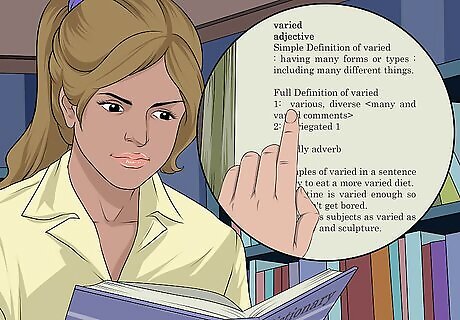
Look up the meaning of words you do not understand. You should focus on analyzing the poem on a deeper level by looking at the word choice in the poem. There may be words you understand and words that are unfamiliar to you, as well as words that have multiple meanings. Look up any words that you do not recognize using a good dictionary. Consider how the meaning of the words fit within the rest of the poem. For example, in “I Hear America Singing” by Walt Whitman, you may notice the words “varied” and “blithe”. You may then look up these words and notice how they add meaning to a line in poem or how they add meaning to the poem overall.
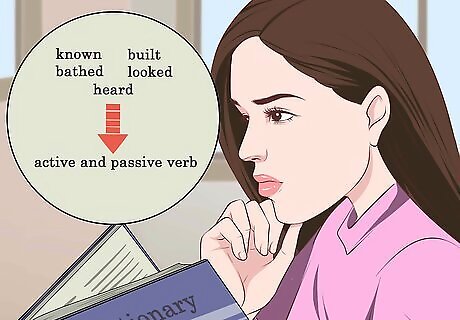
Consider the verbs used in the poem. You should also look at the verbs used in the poem. Verbs imply action and they can often tell you what is going on in the poem on a deeper level. Underline the verbs in the poem and consider how they function in each line of the poem. For example, if you analyzing Langston Hughes’ poem “The Negro Speaks of Rivers”, you may notice that Hughes uses the verbs “known”, “bathed”, “built”, “looked”, and “heard”. These verbs are a mix of active and passive verbs, where the speaker is doing something actively, like bathing or building, and then becomes more passive, such as looking or hearing.
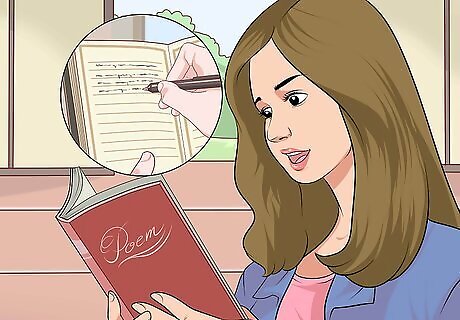
Note the sound and rhythm of the poem. You should read the poem out loud and consider how certain lines sound. Is there a rhythm or a rhyme to the lines? Are certain words emphasized in the poem because of the way the lines are broken up or due to a rhyming pattern? You should consider how these elements relate to the poem’s meaning. You should also think about the effect created by the sound and rhythm in the poem. You should try to identify the metrical pattern of the poem. Does every other line rhyme or every third line? Is there alliteration, where words start with the same letter in a row in the same line? For example, you may be analyzing the poem “The Rime of the Ancient Mariner” by Samuel Taylor Coleridge. You may notice that the poem follows a certain rhyming pattern, where the second and fourth lines of every stanza rhyme. In contrast, you may look at “I Hear America Singing” by Walt Whitman, where there appears to be no rhyming in the poem. But you may notice that the poem still has a certain rhythm when read out loud.
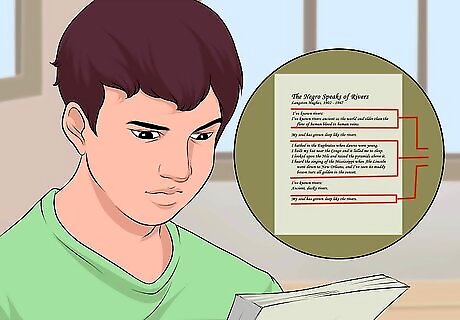
Look at how the poem is ordered or sectioned off. You should pay close attention to how the poem’s lines are divided or sectioned off. The lines may be broken into stanzas, where there is the same number of lines in each stanza. Or the lines may be separated using line breaks, where the line seems to shift right or left across the page. The sectioning of the lines was done on purpose by the poet so you should consider how it adds to the meaning of the poem. For example, in Langston Hughes’ poem “The Negro Speaks of Rivers”, you may notice that the third line of the poem is indented so there is a line break. This creates a certain rhythm when the poem is read out loud or in your head, putting a stress on the word “flow”, and making you pause on the last line of the stanza. You may also notice that the fourth line of the poem stands on its own as a single line. Hughes seems to be trying to emphasize the importance of this line, forcing the reader to slow down and take in the line as a whole.

Note the mood of the poem. The mood of the poem can be creepy or unsettling, or it can be matter of fact and friendly. The mood is often evoked using word choice, rhythm, imagery, and description. Determining the mood of the poem can help you access a deeper meaning. Ask yourself, what is the sense I get of the poem when I read it? How do I feel when I read it? For example, “I Hear America Singing” by Walt Whitman, you may feel the mood of the poem is celebratory and joyous, particularly with the use of the words “delicious”, “robust”, “friendly”, and “melodious”.
Pay attention to the poem’s tone. The tone in the poem is based on how the speaker sounds or appears to view their subject, which depends on how they feel about their subject. The speaker’s tone could be happy, sad, angry, critical, or distant. For example, the tone of the speaker in “I Hear America Singing” by Walt Whitman appears to be thoughtful, observant, and appreciative of the songs America sings.

Identify the form of the poem. You should identify the form of the poem to deepen your understanding of its meaning and intent. You can use elements like rhyme scheme, section breaks, and word choice in the poem to help you identify the form. For example, if you were analyzing “I Hear America Singing” by Walt Whitman, you may notice that none of the lines rhyme and the lines seem to organized in a free flowing way, with no stanzas and short line breaks. You may then determine that the poem is written in the free verse form. If you were analyzing “The Rime of the Ancient Mariner” by Samuel Taylor Coleridge, you may notice that it follows a certain rhyming scheme and has stanzas that are four or six lines long. You may determine that the poem follows the ballad form, though loosely and with some exceptions.
Deciphering the Figurative Meaning of the Poem
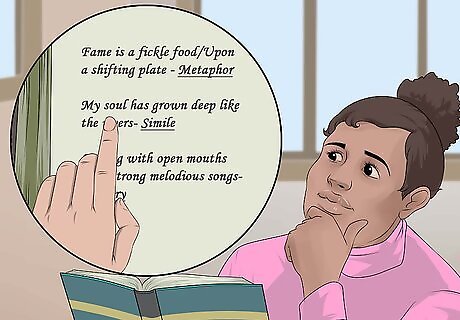
Look for metaphors, similes, and imagery in the poem. To get more into the figurative meaning of the poem, you should look at how the poet uses literary devices like metaphor, simile, and imagery. These devices are often used to add deeper meaning to a line or word, as well as meaning to the poem as a whole. A metaphor is when a subject uses another subject or object to create meaning. For example, if you were analyzing Emily Dickinson’s poem “Fame is a Fickle Food”, you may notice the poem uses the metaphor: “Fame is a fickle food/Upon a shifting plate.” A simile compares two subjects or objects to each other using “as” or “like”. For example, in Langston Hughes’ poem “The Negro Speaks of Rivers”, the speaker uses a simile to describe themselves: “My soul has grown deep like the rivers.” Imagery is used to create mental images or pictures in the reader’s mind. The poet may use metaphor, simile, and other literary devices to create strong imagery in the poem. For example, in “I Hear America Singing” by Walt Whitman, Whitman ends the poem with striking imagery about the songs of America that uses description, strong word choice, and action: “Singing with open mouths their strong melodious songs.”
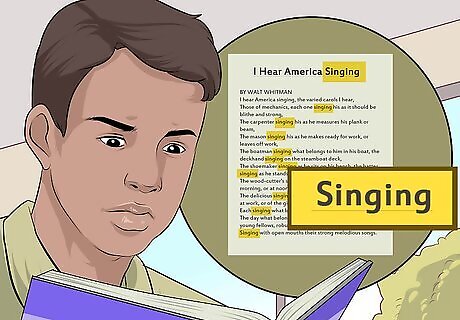
Analyze the figurative language in the poem. You can access the figurative meaning of the poem by considering how the poet uses figurative language. Figurative language could be words that are repeated often in the poem or words that rhyme in each stanza. Figurative language could also be a metaphor or simile that is repeated more than once or that is used to begin or end the poem. For example, in “I Hear America Singing” by Walt Whitman, the word “singing” appears ten times in the poem. This is a good indication that it has figurative depth in the poem that is important and holds meaning. In Emily Dickinson’s poem “Fame is a Fickle Food”, the word “fame” appears only once in the poem in the first line. But it is explored through the use of food imagery, indicating that food is a key figurative element in the poem, especially in relation to fame. Pay special attention to nouns that stand out and seem to have special meaning. These words may be symbolic and figurative.
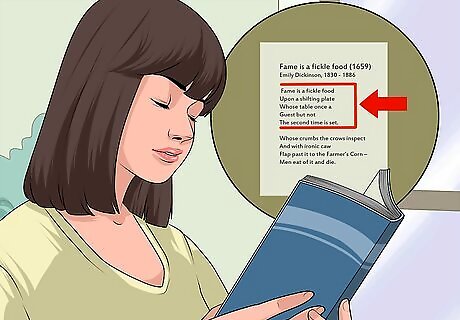
Read the first and last lines of the poem closely. You should also pay attention to how the poet opens and closes the poem, as these lines are often important. The poet may begin with a specific question in the first line that is then answered or addressed in the last line. The poet may also use the first line as a jumping off point, or a point of exploration that is then summed up in the last line of the poem. For example, in Emily Dickinson’s poem “Fame is a Fickle Food”, the first line “Fame is a fickle food” acts as a sort of prompt or proposition. Dickinson then explores this first line in the rest of the poem and ends with a striking line, “Men eat of it and die.” The last line in the poem sums up the first line of the poem by indicating what happens when you try to eat the fickle food of fame and try to enjoy fame. Dickinson suggests that eating fame leads to death, or a very unhappy end.
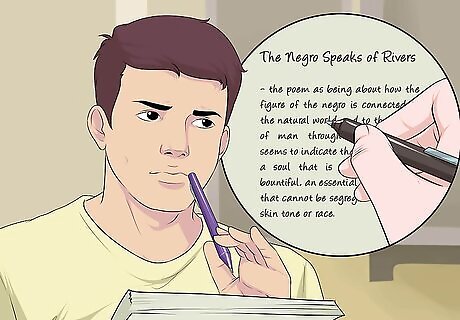
Try to sum up the figurative meaning of the poem in a few sentences. Once you have considered the language use, the imagery, and specific key lines in the poem, you should try to write down the meaning of the poem from your point of view. You can paraphrase the poem in your own words or create a few sentences that sum up the figurative meaning of the poem. Answer the question, What is the poem trying to say? or What was my experience of reading and analyzing the poem? For example, you may paraphrase or sum up Langston Hughes’ poem “The Negro Speaks of Rivers” by focusing on how “the negro” speaker uses rivers to communicate and exist. You may paraphrase the poem as being about how the figure of the negro is connected to the natural world and to the history of man through rivers. You may note that Hughes seems to indicate that the negro has a soul that is deep, wide, and bountiful, an essential part of nature that cannot be segregated based on skin tone or race. Keep in mind there is no one right way to interpret a poem or understand it more deeply. If you have your own specific take on the poem, you should use evidence in the poem to support your interpretation and explore it more fully.



















Comments
0 comment